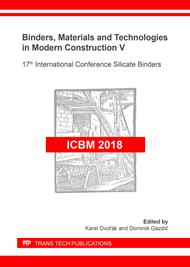[1]
J.C. MacGregor, Reinforced concrete – mechanics and design, 3rd ed., Prentice-Hall, Inc., Upper Saddle River (NJ), (1997).
Google Scholar
[2]
J. C. McCormac, J.K. Nelson, Design of reinforced concrete, 10th ed., John Wiley & Sons, Inc., USA, (2015).
Google Scholar
[3]
P. Bamonte, F. Lo Monte, Reinforced concrete columns exposed to standard fire: Comparison among different constitutive models for concrete at high temperature, Fire Safety Journal, 71, 2015, 310-323.
DOI: 10.1016/j.firesaf.2014.11.014
Google Scholar
[4]
J. C. Lacouture, P. A. Johnson, F. Cohen-Tenoudji, Study of critical behavior in concrete during curing by application of dynamic linear and nonlinear means, The Journal of the Acoustical Society of America, 113 (3), 2003, 1325–1332.
DOI: 10.1121/1.1543927
Google Scholar
[5]
K. Warnemuende, H. C. Wu, Actively modulated acoustic nondestructive evaluation of concrete, Cement and Concrete Research, 34 (4), 2004, 563–570.
DOI: 10.1016/j.cemconres.2003.09.008
Google Scholar
[6]
J. D. Stauffer, C. B. Woodward, K. R. White, Nonlinear ultrasonic testing with resonant and pulse velocity parameters for early damage in concrete, ACI Materials Journal, 102 (2), 2005, 118-121.
DOI: 10.14359/14305
Google Scholar
[7]
Ju-young Hwang, Hyo-Gyoung Kwak, Jinwook Hwang, Yonghoon Lee, Wha-Jung Kim, Fire-resistant capacity of RC structures considering time-dependent creep strain at elevated temperature, Magazine of Concrete Research, 68 (15), 2016, 782-797.
DOI: 10.1680/jmacr.15.00170
Google Scholar
[8]
G. A. Khoury, Effect of Fire on Concrete and Concrete Structures, Progress in Structural Engineering and Materials, 2 (4), 2000, 429-447.
DOI: 10.1002/pse.51
Google Scholar
[9]
K. Van Den Abeele, J. De Visscher, Damage assessment in reinforced concrete using spectral and temporal nonlinear vibration techniques, Cement and Concrete Research, 30 (9), 2000, 1453-1464.
DOI: 10.1016/s0008-8846(00)00329-x
Google Scholar
[10]
P. Misák, T. Stavař, I. Rozsypalová, D. Kocáb, P. Possl, Statistical view of evaluating concrete-surface-layer permeability tests in connection with changes in concrete formula, Materiali in Tehnologije, 51 (3), 2017, 379-385.
DOI: 10.17222/mit.2015.223
Google Scholar
[11]
I. Solodov, N. Krohn, G. Busse, Nonlinear ultrasonic NDT for Early defect recognition and imaging, Proceedings of the 10th European Conference on Non-Destructive Testing, Moscow, (2010).
Google Scholar
[12]
J. Kober, Z. Převorovský, Theoretical investigation of nonlinear ultrasonic wave modulation spectroscopy at crack interface, NDT & E International. 61, 2014, 10-15.
DOI: 10.1016/j.ndteint.2013.09.001
Google Scholar
[13]
I. Solodov and M. Kreutzbruck, Resonant Defects: A New Approach to Highly-Sensitive Ultrasound Activated NDT Techniques, in 19th World Conference on Non-Destructive Testing Munich, Germany, 2016, 1–7.
DOI: 10.12737/23496
Google Scholar
[14]
R. Štoudek, T. Trčka, M. Matysík, T. Vymazal, I. Plšková, Acoustic and Electromagnetic Emission of Lightweight Concrete with Polypropylene Fibers, Materiali in tehnologije. 50(4), 2016, 547-552.
DOI: 10.17222/mit.2015.138
Google Scholar
[15]
F. Moradi-Marani, S. A. Kodjo, P. Rivard, C. P. Lamarche, Journal of Nondestructive Evaluation, 33 (2), 2014, 288–298.
Google Scholar
[16]
P. Misák, P. Possl, D. Kocáb, I. Rozsypalová, T. Stavař, Evaluation of permeability tests of surface layer of concrete of various composition, Key Engineering Materials. 714, 2016, 171-178.
DOI: 10.4028/www.scientific.net/kem.714.171
Google Scholar
[17]
J. Hettler, J. Kober, Z. Převorovský, Monitoring of the Damage Evolution in Concrete Slabs by Means of Nonlinear Elastic Wave Spectroscopy, Proc. of the 42nd International Conf. on NDT ´NDE for Safety - Defektoskopie 2012´. Seč u Chrudimi, Czech republic, 2012, 301-308.
Google Scholar
[18]
M. Matysík, I. Plšková, Z. Chobola Assessment of the Impact-echo Method for Monitoring the Long-standing Frost Resistance of Ceramic Tiles. Materiali in tehnologije. 49 (4), 2015, 639-643.
DOI: 10.17222/mit.2014.155
Google Scholar
[19]
C. Payan, V. Garnier, J. Moysan, P. A. Johnson, Applying nonlinear resonant ultrasound spectroscopy to improving thermal damage assessment in concrete, The Journal of the Acoustical Society of America, 121 (4), (2007).
DOI: 10.1121/1.2710745
Google Scholar


